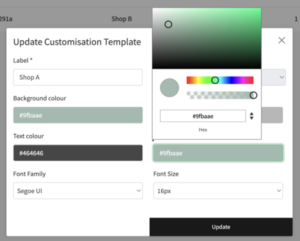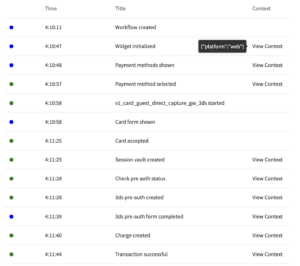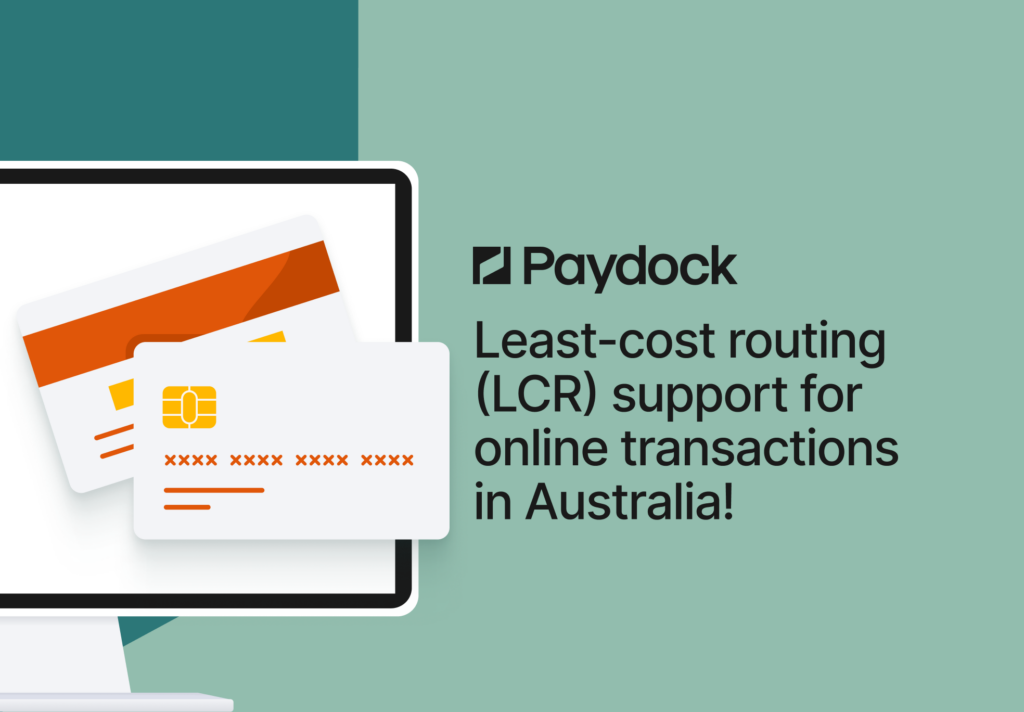In today’s fast-paced market, merchants must adapt quickly to new payment methods, shifting customer preferences and important compliance and security demands.
This is where Paydock’s Checkout comes in—a revolutionary orchestration service that defines the future standard of payment acceptance.
By simplifying and streamlining the integration process, it reduces complexity, allowing merchants to introduce new payment options and adjust to market demands with 100x greater speed and efficiency.
But before diving into how this feature works, I wanted to first explore two key challenges we addressed when designing Paydock Checkout and at a high level how how we solved them, learning from nearly a decade of frontline experience.
Speed to Market
Time and effort required for integration are paramount for merchants, as is the appetite to be increasing security, resilience, analytics and of course, competitive advantage.
Combined with the variety of payment methods and the need to support them across various platforms heavily influence the speed and resource needs of integration.
As part of designing Paydock Checkout, drawing on years of knowledge and first-hand experience, we realised that it was critical that we find new ways to drive service adoption and modification effort to effectively zero.
Speed of Response
The ability to quickly understand and make changes to a payment environment impacts not only market changes but also security and resilience.
We have seen three primary drivers of this need over the years.
- Desire to analyse end-to-end (E2E) payment processes to gain insights into user behaviour and adapt processes.
- The capability to rapidly introduce new payment options as they emerge.
- Adjusting payment flows in response to business changes for cost efficiency.
We knew, that as part of this experience, it was critical that merchants also maintain total visibility of consumer engagement across their checkout journey.
A final comment needs to be made about security. Even ‘low-code’, while an improvement on a typical modular API-driven integration suite was not as effective as a genuine no-code solution.
We also need to bear in mind the critical importance of security, often differing across platforms, potentially complicating security management.
Consider, for example, a merchant system comprising web applications, mobile applications, e-commerce systems, and a backend. Payment flows traverse these components, and the merchant can exert control over the process.
The quantity of integration points and components involved affects how quickly the business can respond to market shifts, depending on the merchant’s available resources for technical adaptation.
In summary, the speed of integrating payment systems and responding to market changes depends on the resources available to merchants.
These resource requirements grow with the variety of payment options, payment flows, and platforms that need to be supported.
Paydock Checkout was specifically designed to intentionally address each of these challenges, equipping in an elegant way merchants to streamline their integration processes and adapt more efficiently to market demands.
Why Paydock Checkout
At its core, this new feature introduces an orchestration layer that fundamentally redefines how payment integrations are managed and supported. Our solution is built on three key principles:
- Removing the merchant from manual effort in the middle of the payment processing flow.
- Transforming decisions that were previously made during processing into configurable elements which can be modified dynamically or automatically.
- Ensuring that configurations are not hard-coded into the merchant’s systems.
By adhering to these principles, merchants can focus on their core business while the orchestration layer handles the complexity of payment integration and processing.
No-code Configuration
Paydock Checkout’s genuinely no-code configuration solution allows merchants to create and update templates for payment methods and visual components without modifying their code. These templates are platform-agnostic, ensuring a consistent management experience across web, mobile, and e-commerce systems.
Merchants can administer these configurations either through a dashboard or within external systems, such as e-commerce platforms. We will unpack more on these later however a few screenshots below show how merchants can manage these templates directly in the console.
Merchants can edit the look, feel, processing, fraud, authentication and version of the widget currently deployed to the checkout (and more).
Paydock Checkout defines a new market standard in ease of payments integration and extensibility.
Runtime Solution
In runtime, the orchestration layer simplifies interactions to two key touchpoints (intent and outcome).
- The intent represents instructions based on the configuration template
- While the outcome refers to the final processing status.
With no further action required from the merchant, the system ensures reliable execution, including the cleanup of processing artefacts and rollback of business transactions.
Analytics
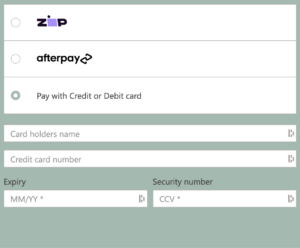
Merchants gain detailed insights after processing is complete, with data provided in a unified format across all platforms. This includes step-by-step information on user interactions, successful and failed payment attempts, and the involvement of key business entities throughout the process.
This fine-grained insight into the entire customer and payment journey equips swift triage and runtime modifications to drive uplift in payment performance and conversions.
Resilience
In case of a failure of any component, whether external or internal or business error, the system ensures the reliability of the flow and completes it correctly automatically.
For example: automatic voiding of the payment transaction or clearing the payment data storage if the customer leaves the process midway or the merchant cannot obtain the transaction status.
Paydock Checkout provides a major boost to the already market-leading reliability of the Paydock platform de-risking merchant choices of processing partners while ensuring benchmark SLAs.
Security
By removing the merchant from the middle of the payment process, the system simplifies security management. This approach eliminates shared responsibility for security during processing, allowing merchants to configure security settings outside their core code.
The days of hard-wiring an API key into the code base or exposing a security flaw on the front end are closed, as Paydock Checkout handles payment actions inside our compliant processing engine.
Paydock Checkout Architecture
To achieve all of this, we developed a new orchestration layer to build on the existing orchestration assets, centralised on the server side.
This layer ensures control over all participants in the processing chain, plus consistency across all platforms combined with flow control over external and internal components – with industry leading security and reliability in mind.
Configuration Module
The configuration module is implemented on a new server through unified contracts, which can be integrated into any administrative dashboard. The contracts control both validation and UI/UX and have version control. Thus, a single unified no-code administrative interface has been created, available on various platforms. This also supports our white-label engine, designed for easy roll out by our financial institution partners.
Intent Module
The Intent Module simplifies the merchant’s role in the payment process by providing a single endpoint, “intent,” that initialises the entire checkout session. This endpoint takes essential checkout details such as the amount, reference, and configuration—either directly or through pre-d
efined templates. By invoking this endpoint, the merchant effectively hands off control to the orchestration layer, which manages the entire process from start to finish ‘under the hood’.
Once the session is created, represented by a session key, the merchant is no longer involved in the workflow, the orchestration layer now ensuring that everything, from payment method selection to transaction completion, is handled seamlessly. This materially reduces the complexity, security and technical burden for merchants, allowing them to integrate with just one call and focus on their core business, leaving the intricate processing details to the orchestration system while giving their consumers a market-leading solution and competitive advantage.
Widget Module
A new widget has also been introduced, differing significantly from previous widgets and unpacking a host of new benefits to merchants and institutional partners. The widget provides the merchant with the ability to integrate in just two lines of code: a session token and the status of the process completion. This could be regarded as the last payment integration the merchant will ever need to do. This collapses the integration cost and effort by many orders of magnitude, even from a low-code (let alone traditional modular) perspective.
The widget is managed by the Paydock orchestration platform, where all decisions, including what the customer sees and in what order, are made. The orchestration engine sends commands through unified interfaces, making the orchestration truly end-user platform-agnostic; web, mobile, etc.
Processing Module
The new orchestration layer leverages the system’s capabilities to manage payment providers and value-added services, delivering reliable and cost-efficient processing options.
Even with the revamped checkout flow, the impact on existing business processes is minimal, mirroring alternative processing methods.
Merchants retain the ability to utilize processing artifacts from individual payment methods outside of checkout, along with features like reporting and notifications.
Essentially, the merchant’s workflow remains largely unaffected.
Analytics Module
Centralized server-side processing captures a wealth of new execution data which is now available to the user and does all the heavy lifting for the merchant, including processing details, configurations, device information, and user behaviour. This enables us to track the complete user journey, background operations, fallback scenarios, and gather key metadata like the device used for checkout.
We also record information about successful and unsuccessful processing attempts, along with any changes the user makes to their payment method during the process.
Core Orchestration
The core orchestration engine interacts with numerous external and internal components, managing business flows, data flows, security, and execution states based on a platform-agnostic intent template.
Built on a workflow engine, the Core Orchestrator ensures reliable state management, handling failures or external business errors gracefully. It’s designed to be fault-tolerant, capable of correctly handling any scenario, even after external component failures, and restoring data to a consistent state upon recovery.
These considerations matter equally to us as payments orchestrators as much as they do to the merchant. Picture a collection of independent business payment operations ( like displaying a payment method widget or making an API call to create a transaction) presented as a structured framework.
This framework incorporates security measures, error handling, analytics, and decision-making capabilities.
We use this framework to construct diverse and intricate payment processes, prioritizing the business logic over the technical nuances of each operation or platform.
Centralizing orchestration has united all stakeholders around our innovative checkout process framework, simplifying the addition of new cost-effective and reliable payment flows. This directly benefits the merchant by enabling us to rapidly introduce new features in response to market opportunities or changing customer payment patterns, ensuring they remain competitive and at the forefront of payment technology.
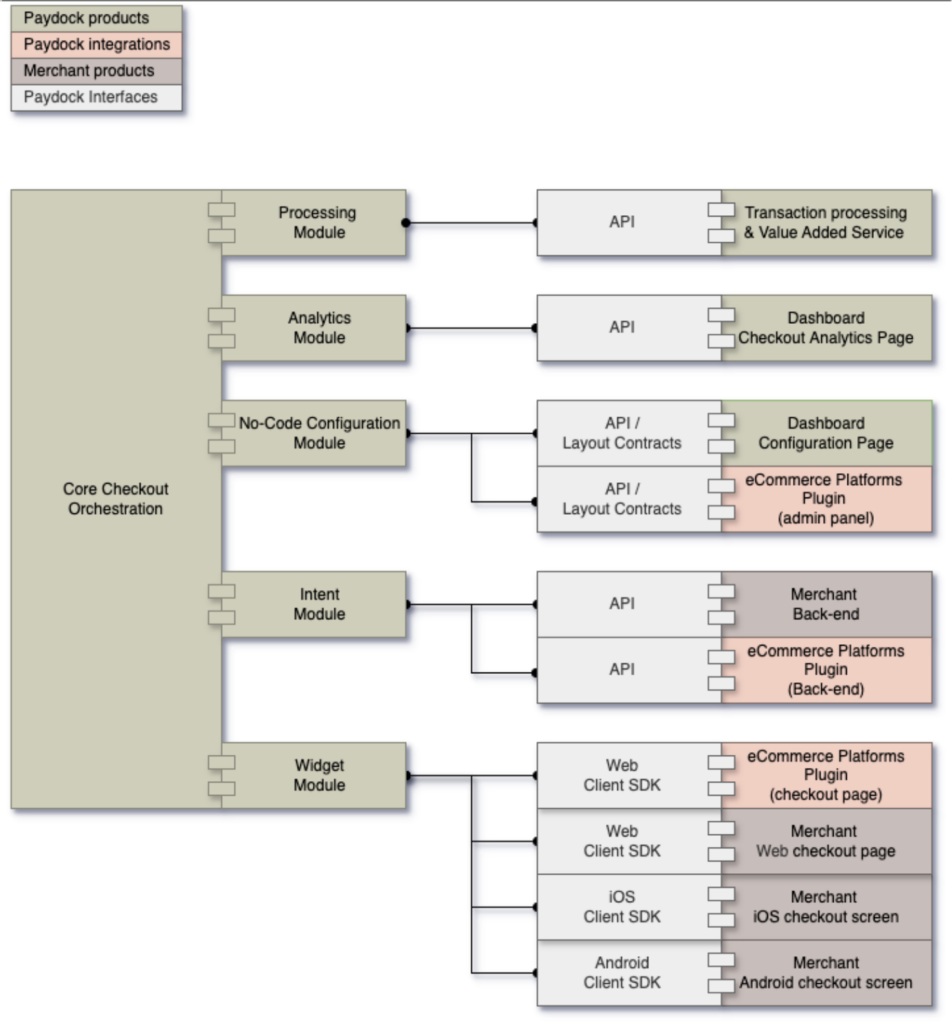
Paydock Checkout High Level Architecture
Summary
In summary, the new orchestration layer’s architecture effectively solves the market’s long held need for rapid merchant integration and responsiveness to market shifts, without complicated and costly additional integration effort.
By offering no-code solutions for checkout process management and reliable, fault-tolerant processing, the speed of integration and response is no longer directly tied to resource availability. Moreover, the merchant gains access to pre-built, cost-effective flows, eliminating the need for extensive domain expertise.
This translates to a cost and time-efficient solution that, when combined with payment provider orchestration, provides the merchant with a distinct competitive edge.
As we continue to extend and build on Paydock Checkout we look forward to extending our lead in defining the future standard for payments, commerce and merchant experiences. As the cost and effort to adopt (and distribute) fintech trends increasingly toward zero, we also look forward to greater innovation and delighted merchants as we ‘get out of the way’ and enable our valued industry participants to do what they do best.
We’re very excited to see what our partners do with Paydock Checkout and can’t wait to share their successes with you.
